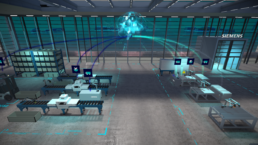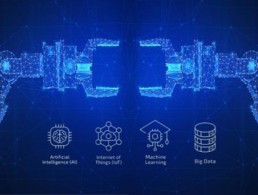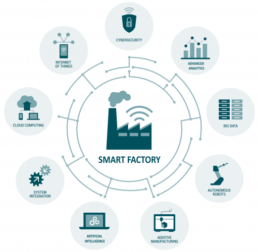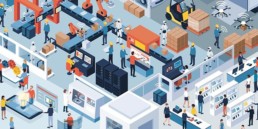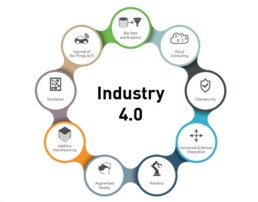Siemens teams up with Google Cloud for AI-based solutions in manufacturing
Google Cloud and Siemens, an innovation and technology leader in industrial automation and software, on Monday announced new cooperation to optimize factory processes and improve productivity on the shop floor.
Siemens intends to integrate Google Cloud’s leading data cloud and artificial intelligence/machine learning (AI/ML) technologies with its factory automation solutions to help manufacturers innovate for the future, says a joint press release.
By combining Google Cloud’s data cloud and AI/ML capabilities with Siemens’ Digital Industries Factory Automation portfolio, manufacturers will be able to harmonize their factory data, run cloud-based AI/ML models on top of that data, and deploy algorithms at the network edge. This enables applications such as visual inspection of products or predicting the wear-and-tear of machines on the assembly line.
“The potential for artificial intelligence to radically transform the plant floor is far from being exhausted. Many manufacturers are still stuck in AI ‘pilot projects’ today – we want to change that,” Axel Lorenz, VP – control, factory automation, Siemens Digital Industries, said.
“Combining AI/ML technology from Google Cloud with Siemens’ solutions for Industrial EDGE (Enhanced Data GSM Environment) and industrial operation will be a game-changer for the manufacturing industry,” he added.
The goal of the cooperation between Google Cloud and Siemens is to make the deployment of AI in connection with the Industrial EDGE and its management at scale - easier, empowering employees as they work on the plant floor, automating mundane tasks, and improving overall quality.
“This cooperation will combine the best of both worlds and bring AI/ML to the manufacturing industry at scale. By simplifying the deployment of AI in industrial use cases, we’re helping employees augment their critical work on the shop floor,” Dominik Wee, managing director - manufacturing and industrial, Google Cloud, said.
The Time is Now to Move to Smarter Manufacturing
Ride the Wave of Smarter Manufacturing
The year 2020 sparked a tremendous acceleration in the digital transformation worldwide, driving a sharp rise in demand for semiconductors and escalating pressure on chip factories to reduce manual functions on the shop floor. The mindset of the semiconductor industry saw a remarkable shift as it recognized with heightened urgency the need to deploy data-driven visualization, analysis, scheduling and dispatching solutions to increase automation to improve production speed and efficiency.
Amidst the new excitement around Industry 4.0, chip manufacturers are rapidly deploying new technologies including IIoT, big data, machine learning and Autonomous Intelligent Vehicles (AIVs). Yet for many chip manufacturers, the path to building a smart factory is far from clear because they lack an overall digital transformation strategy.
Smart manufacturing is a broad concept covering an array of technologies and solutions, making a holistic, mid- to long-term digitalization strategy rooted in the overall business strategy crucial. There are no shortcuts that can move a manufacturer instantly to Industry 4.0. Instead, this transformation is a step-by-step undertaking with a natural evolution.
Some Factory Tasks Must Remain Manual – For Now
The semiconductor industry has reached a point where manual processes are no longer efficient enough to support mass chip customization and remote operations. The many technological and standardization advances behind automation can help streamline some of a factory’s most labor-intensive tasks including the loading or unloading of machines or lot tracking and data collection while reducing operational costs.
Still, some tasks remain very difficult to automate. For example, handling errors and exceptions presents the greatest challenge since some errors are hard to anticipate. What’s more, the cost of automating error handling can be prohibitive.
Eliminating Gaps in Connectivity
Often, critical data sources aren’t available due to lack of equipment integration, incomplete product quality monitoring or gaps in material tracking. Closing these gaps in connectivity enables the collection of data and provides rich, reliable information for analysis and reporting that can drive continuous operational improvements, optimizations and efficiencies throughout a factory. But keep in mind that data integration alone can be a challenging task. The selection and proper enrichment of relevant data is, in many cases, not just a technical problem but requires a detailed and in-depth knowledge of the manufacturing steps to be analyzed and optimized.
Even when data is available, it might be still difficult to make decisions or implement improvements if it is in siloed systems that require manual processes to integrate and translate into useful information. Problem solving at this level is possible but extremely time-consuming. Manual integration is not only ineffective but costly, draining time, human resources and money from the factory. The right contextual information for the data is vital to unleash its potential and make improvements possible. Dispersed solutions cannot control processes because they span functional areas and people, physical and business entities. Backbone software for shop-floor operations that controls all other applications is central to smart manufacturing.
Data-Driven Manufacturing
The semiconductor industry is expert in data collection and leads many other industries in this area. The problem is often that chip companies use only a fraction of the information they collect for the analysis and insights needed to improve operational efficiency. By comprehensively integrating all distributed data into a single version of truth – in one location where it is always available – companies can make data analysis and problem solving almost frictionless. Keep in mind that data platforms and edge solutions, within the context of manufacturing, will not be adopted as part of a greenfield initiative.
Building a solid automation architecture is only feasible and beneficial by deploying new technologies such as machine learning and artificial intelligence (AI). Analysis of historical data provides important context and reveals deviations such as unexpected process time, uncommon material accumulations or issues with material transport. By integrating swift control actions for new data point collected, manufacturing operations can shift from reactive problem-solving to proactive analysis and operational improvements.
The tremendous increase in interest and investment in AI for manufacturing automation only became possible with the availability of low-cost sensors that generate huge volumes of data and solutions for storing and processing that at low cost. AI and other leading-edge technologies transform the tedious but critical process of extracting insights from data, making it instantaneous, streamlined and achievable for every manufacturer.
The maturity of smart manufacturing hinges on the extent to which a factory is data-driven. This requires foundational investments to improve traceability, connectivity and real-time operations – and finally making sure that data helps us what to do and when to do it.
A Strategy To Maximize AI and the IoT
The combination of Artificial Intelligence (AI) techniques with Internet of Things (IoT) capabilities carries huge potential to improve industrial operations and how consumers interact with their connected devices and services. This is possible because of affordable connectivity, an abundance of data, and advances in AI/Machine Learning (ML) techniques. Together, these three ingredients are the recipe for faster adoption of digital technology. There is a deeper significance, however, from the innovation they enable and the impact this will have on digital transformation in corporate, consumer, and industrial sectors of the economy.
AI for the IoT
The rate at which the population of connected devices is growing has led to predictions that the global market for IoT end-user solutions is expected to be around $1.6 trillion by 2025. A recent white paper on the EU’s approach to AI cites a growth in the worldwide production of data from 33 zettabytes in 2018 to 175 zettabytes in 2025.
Analysing that data, developing insights, and making decisions based on what is revealed is beyond the capacity of mere mortals, especially when it has to happen in real time. Consider the example of predictive maintenance in an industrial setting. This is a procedure that aims to anticipate component failure in a machine and trigger preventive maintenance. It can prevent damage arising from an unforeseen incident and helps organisations to plan any operational downtime.
Being able to predict when a machine is about to break relies on the analysis of many different data points and the application of a range of AI and ML technologies including ad hoc statistical analysis, predictive modelling, text analytics, optimisation and real-time scoring. All of these take place in the blink of an eye and involve the integration of many separate and different functions and hardware components. It also involves 24/7 vigilance, year in and year out.
Opportunities to apply AI with IoT
There are three main ways in which AI applications and IoT devices can interact in different consumer and industrial deployments. Firstly, and most simply, devices in the IoT domain provide information for use in the AI domain where, knowledge-based analysis and decisions are made. This is a case of AI running on top of the IoT domain.
Secondly, AI can be applied inside the IoT domain itself. An example might involve knowledge-based checks on whether a sensor is working correctly and providing uncorrupted data to applications in the AI domain. This captures situations where data might be compromised because of a faulty sensor or due to an unplanned break in transmission. In addition to statistical checks, the use of AI might involve comparisons against a digital ‘twin’ to detect whether a sensor is operating in a degraded manner. By making sure the data reaching it is correct, applications in the AI domain are saved from the additional workload of performing data verification tasks.
The third model of interaction involves reasoning relationships between applications in the AI and IoT domains. These relationships provide the foundations for explainable-AI and trustworthy-AI. Consider the case of an AI application that signals an incipient fault in a mission critical machine. Before that machine is taken out of service for maintenance, a technician would seek an explanation of the chain of logic, provenance of data and the anomalies that led to a fault being deduced. To place trust in a decision from an AI system, the technician might rely on profile and historical data about an IoT sub-system. Profile data might include information about the supplier as well as certification credentials or security capabilities engineered into the sub-system. Historical data might include information about the regularity of calibration tests and updates to firmware and security credentials over time.
Importance of repeatable and interoperable solutions
The three models of AI and IoT domain interactions apply to all consumer and industry application domains. To capture economies of scale and deliver the benefits of repeatable solutions, the integration of AI and IoT solutions needs to ensure that different parts of the ecosystem are compatible with each other. That would make frequently used AI capabilities, such as feature classification or pattern recognition, comparable to common IoT services such as device management, data discovery and security. Through this perspective, developers and solution providers would draw from a toolbox of reusable AI and IoT services to build interoperable solutions. This is where the use of a global interoperability standard is hugely advantageous.
To address the emerging need for AI in IoT, a new, standards-based initiative is mapping out an architecture for how IoT systems can make use of AI and ML to manage and apply IoT data over a variety of deployment models – for example, edge or cloud-based – while remaining interoperable, secure and manageable. It will consider architecture evolutions based on an analysis of representative use cases. Over the course of 2020, the study group will share insights from its analysis and illustrate key concepts through a proof of concept. This work will reuse standardized IoT tools, building on the horizontal architecture defined by oneM2M standards.
A symbiotic relationship
IoT devices and AI applications have a symbiotic relationship. Connected devices need the computing power of AI to make sense of and utilise the vast amounts of data they create. AI applications need IoT devices to provide them with the quality of information needed to make complex and rapid decisions backed up by transparent reasoning. Well-engineered interactions between data and intelligence across AI and IoT domains will play a pivotal role in delivering the breakthroughs that have been predicted to transform our homes, cities and working lives.
5G and Wireless IoT Spurring Smart Factory Success
Transformation feels like an overused term at this point. And while those 14 words are seemingly inescapable when spanning headlines or speaking to service providers and vendors, in regard to the smart factory and 5G, it is embraced.
Put frankly, factories are inefficient, but by welcoming Industry 4.0 IoT solutions enable the exchange of data, empower with automation and enact AR to provide proactive and prescriptive maintenance and self-healing production lines.
“5G is well positioned to address evolving smart factory needs because of its ability to manage higher bandwidth requirements, reduce latency needed for data processing required on the factory floor, and support the big data volumes necessary from connected equipment,” noted a recent whitepaper from Rohde & Schwarz.
Taking place on March 2nd the webinar, “How 5G and Wireless IoT is Enabling the Smart Factory” offers industrial engineers, operations managers, IT and other pertinent team members insight into what wireless technologies are available, outline summing challenges, highlight best practice and educate on the importance of wireless testing.
James Brehm and Olga Yashkova from James Brehm & Associates will be joined by Joerg Koepp and Melik Kottkamp of Rhode & Schwarz for the hour-long event, bringing attendees unique expertise and perspective on this developing arena.
“By investing in 5G technology along with effective and reliable testing solutions, manufacturers will have fast, secure, and reliable wireless internet, allowing for more advanced services and improved productivity.”
The wait for 5G is over. And it’s living up to the hype.
5G & Wireless IoT Overcome Common Connected Factory Challenges
The IoT is no longer a pipe dream. We are well beyond doodling on cocktail napkins; instead, innovation is crafting a connected world. These billions of connected devices deployed around the globe are proving quite the transformational force, and one arena braced for a tidal wave of impact is the factory.
The challenges in the factory setting are many. High costs, antiquated techniques, broken supply chain, lack of production visibility and lack of integration are driving inefficiency.
Many factories are hamstrung with wired connectivity, as earlier wireless technologies were simply not capable of providing the necessary high-speed bandwidth and building penetration. Interoperability is quite the hindrance, as well. The general deficiency of common software interfaces, standard data formats and common connectivity protocols presents “communications issues.”
In addition, security issues are prevalent. Common security pitfalls include the age and diversity of devices on network; vulnerabilities and flaws in the operating systems and Malware – and we’re just getting started. Don’t forget about scale of the network, and the sheer volume of connected devices.
Fragmentation is not a factory’s friend, as it is an arbiter of elevated costs, increased risks, longer time to market and lost resources. Speaking of resources, data is a company’s most valuable resource, whether its proprietary or other sensitive information, managing said data effectively can prove a herculean task.
Aside from properly protecting proprietary data, the increased use of videos and sensors is propelling data growth, and serving as impetus for factories to take a deeper dive into practices, processes and protocols.
Factory communications require the “magic triangle” of reliability, security and latency. 5G and Wireless IoT are enabling the Smart Factory, overcoming common industry challenges with modern connectivity solutions.
In a recent webinar, James Brehm Chief Technology Evangelist, James Brehm & Associates, Olga Yashkova Principal Consultant - IoT Business Intelligence & Analytics, James Brehm & Associates, Joerg Koepp Market Segment Manager, Test & Measurement Division, Rohde & Schwarz and Meik Kottkamp Principal Technology Manager, Test & Measurement Division, Rohde & Schwarz illustrate how wireless IoT is destined to make today’s factories.
Smart Factory Predictions for 2021
2020 brought significant technological changes to factories across the world. Throughout the COVID-19 pandemic, employees and instantiations have had to adapt by working with the best tech.
Now, these factory innovations are a sign of what’s to come in 2021. In many factories, smart technology is paving the way.
IoT
The Internet of Things (IoT) has taken off in powerful ways. For factories, IoT gadgets and systems are invaluable for optimizing operations. For instance, workers can integrate sensors on machinery that transmit data back to a central hub.
Then, workers get a better idea of how machinery is performing. These sensors can transmit how many products a robotic arm assembles and how efficient it is compared to others. With this information, managers and supervisors should be able to get a handle on production.
Generating this data is critical for the factory. It helps managers stay on top of revenue and understand where production needs to go for success.
Robotics and Automation
Streamlining workflows is the underlying theme for 2021. The pandemic brought the need to physically distance and provide safe work environments for employees. Automating processes will continue to become more popular throughout the upcoming year.
For instance, robotics are critical for factories. These robots can work with other robots or with human employees as well. A manufacturing line can have employees assembling complex parts while robots handle repetitive or tedious tasks.
Robots can operate through automation as employees program them with various algorithms that keep them running. The tech will integrate well with IoT sensors, bringing the factory to a new level.
5G
With promises of 5G throughout 2020, the next year will see the global rollout of the fifth-generation network. For factories, 5G means faster connectivity, which is essential for processing the vast amounts of data from IoT sensors and automated systems.
With all the data factories rely on, 5G networks will be invaluable. Experts expect that the new network will be around 100 times faster than 4G. Instant transmission of data from machinery to managers, from factory to factory and across the supply chain will be possible.
These high-speed changes are a big step forward for wireless connectivity. 2021 will see a more robust rollout.
3D Printing
3D printing isn’t especially new, but it is an up-and-coming field within factories. It’s a cost-effective and fast way to produce materials and finished products. The previous obstacle with 3D printing is that it was too expensive and materials were relatively hard to come by.
However, 2020 brought an abundance of these materials — like plastics and resins — for manufacturing. Now, going into next year, factories will adapt to this smart innovation.
3D printing allows inexpensive part production — factories will no longer need to wait on supply chains, domestic or international, to provide them with materials. Instead, they can produce it all themselves.
Sustainability
Sustainability is a necessity. Factories can adapt to new, innovative ways to operate without harming the environment. For instance, more efficient packaging can save materials and energy.
Predictive maintenance through IoT sensors can also save energy, costs and waste. They transmit data from machinery about their performance and status. Then, when equipment has low performance rates, employees can fix parts before things break and need replacing.
Factories contributed to 22% of industrial emissions in 2018. After making more sustainable changes, renewable energy — which uses smart tools like IoT — will bring those emission levels down.
The Changing Landscape
These smart factory predictions for 2021 show what’s to come. While these tech areas all have a footing in 2020, the coming year is when they will truly begin to thrive. Moreover, factories are already adapting to the changes.
Delivering IoT-Centric Factory Automation with Wi-Fi HaLow Technology
Companies across all industries and geographies are harnessing the power of the Internet of Things (IoT) to derive more value and efficiency from their logistics and supply chains operations. IoT-enabled asset tracking, for example, enables businesses to pinpoint the location and condition of assets, anywhere and anytime throughout the shipping process. According to Data Bridge Market Research, the global market for asset tracking and inventory management solutions will continue to grow steadily in the coming years, reaching $41.24 billion (USD) by 2027 and achieving a market growth rate of 13.7 percent during the 2020-to-2027 forecast period.
End-to-end asset management systems based on IoT platforms provide a comprehensive view of raw materials, works in progress (WIP), finished goods inventory and real-time tracking, extending from the fulfilment process to end-customer delivery. Assessing the health of capital equipment used to produce and move these goods minimizes cost repairs, downtime and outages. Businesses gain a big picture of the logistics chain using wireless sensors that provide data on the location of high-value cargo. Whether a company owns the complete logistics chain or shares resources with other companies, decision makers requires a transparent view of real-time information at every point. Comprehensive supply chain management systems ultimately enable predictable planning, minimal inventory loss, regulatory compliance and satisfied customers.
While corporations recognize the tremendous value that the IoT brings to asset management, the challenge is to seamlessly link remote sensors wirelessly to the internet across multiple sites and indoor/outdoor locations. The ideal wireless technology should be standards-based, cost-effective, low power to sustain long battery life and able to span long distances. Wi-Fi HaLow, an industry-standard wireless solution (IEEE 802.11ah), provides an optimal choice for asset tracking and supply chain systems requiring a secure, bidirectional flow of information. A sub-1 GHz protocol, Wi-Fi HaLow uses narrower channels than 2.4 GHz, 5 GHz and the newly added 6 GHz versions of Wi-Fi. Wi-Fi HaLow also provides a low-power, long-range solution at a much higher throughput than any other proprietary wireless technologies that would fall short on reach, data capacity and battery life.
Equipment suppliers can use optimized Wi-Fi HaLow chips and protocol stacks to create wireless asset tags, trackers, scanners and monitors designed to operate across a wide range of distances and data rates. These wireless IoT devices can access the internet through standard HaLow access points (APs) across all logistics and warehousing domains. The following four factory automation and asset management use cases demonstrate the benefits of Wi-Fi HaLow technology for supply chain logistics: tags and trackers, pickers and scanners, large warehouses, factories, and security systems.
Smart Tags and Trackers for Precise Location
Wi-Fi HaLow operates in sub-1 GHz frequencies, using narrower channels than conventional 2.4 GHz Wi-Fi protocols. Wi-Fi HaLow is an ideal wireless technology for tags and trackers because sub-GHz signals reach farther and penetrate objects better than higher frequency protocols at lower total power. HaLow also uses the Wi-Fi standard’s Orthogonal Frequency Division Multiplexing (OFDM) modulation scheme, which enhances the robustness of wireless connections in multipath environments, enabling signals to reflect off of objects.
IoT-connected trackers use long-range wireless networks to enable companies track shipped goods throughout their delivery journeys. Using Wi-Fi HaLow routers, cargo carriers can establish two-way satellite internet connections on trucks, trains, planes, ships and warehouses. Wi-Fi HaLow allows customers to aggregate multiple shipments on board while providing improved connectivity throughout. This capability eliminates concerns about the location of a tag or tracker, even when deployed in numerous containers. Each customer can have separate encrypted L3 tunnels back to their home platforms using internet-ready Wi-Fi HaLow system-on-chip (SoC) devices.
With Wi-Fi HaLow access points on trucks, ships, trains or planes, real-time data from HaLow-enabled sensors can be communicated continuously to all parties along the supply chain. The trackers’ sub-GHz signals can penetrate through bulk materials, enabling connectivity even in densely packed cargo containers. Knowing the precise location and current condition of each container containing perishable goods can help owners determine next steps, such as selecting the best grocery store to receive the shipment at optimal ripeness. Wireless sensor tags can be built using cost-effective coin cell batteries that last for years. The tags can also be reprogrammed and redeployed for future shipments.
Strict compliance with varying government regulations, especially for international shipments, drives the need for wireless trackers throughout the transit process. Transmitting data on cold chain profiles of foods, vaccines or volatile materials requires higher levels of security to prevent contamination and tampering. Many Wi-Fi HaLow SoCs available today include secure boot technology that enables trusted over-the-air (OTA) platform connections of encrypted data. Wi-Fi HaLow data bandwidth enables larger amounts of stored data to be transferred than possible using simple RFID tags or other proprietary wireless network solutions.
Robust Signal Strength for Pickers and Scanners
In addition to providing the bandwidth for secure data transmission, wireless IoT networks for factory automation, logistics and asset management must establish robust connections. For example, mobile workers and automated robotic product handlers on manufacturing and warehouse floors require the flexibility of traversing large expanses without losing connectivity. Wi-Fi HaLow supports robust connections over long distances, enabling forklift operators to move freely across multiple aisles and robotic equipment to deliver stored goods to distant sorting lines.
In warehouses and other large-scale storage environments, signal strength is not the only challenge facing wireless networks. The availability of power is also a concern. Many popular handheld IR scanners, printers, and picking assistance devices must be recharged on a daily basis or plugged into wall power sources to maintain uninterrupted wireless connections. The power required for a Wi-Fi HaLow communications link is a small fraction of the power drain from proprietary wireless solutions. This energy efficiency greatly extends battery life and the time mobile devices can move around the warehouse floor instead of remaining plugged into wall sockets. Wi-Fi HaLow can also be used as a long-distance bridge for RFID scanners requiring mobility to different areas of the warehouse or loading dock.
Bandwidth for Large, High-Density Factories and Warehouses
Today’s large, dense factory and warehouse environments require advanced network infrastructure capable of providing ample bandwidth and enough capacity to support a multitude of wireless sensors and on-site mobile devices. IT organizations for factories, shipping companies and warehouse facilities must support personnel, equipment, robots, security devices, inventory tracking systems, and building automation systems for HVAC, power, lighting and safety.
Legacy wired networks for factory automation are based on proprietary protocols with an infrastructure that is aging quickly and can no longer serve the emerging needs of modern equipment in terms of reach, capacity and security. Supplying wireless service coverage for a 100,000-square-foot factory or warehouse using conventional Wi-Fi in the 2.4 GHz or 5 GHz bands requires many dozens of access points. Each AP will need a Power-over-Ethernet (PoE) cable connection back to a wiring closet switch. In addition, a server-based controller may be required to manage security and roaming. The maximum density of clients served in this manner with conventional Wi-Fi is quite low, ranging in the hundreds of clients per AP.
In contrast, a Wi-Fi HaLow AP signal can reach 10x farther, covering 100x the area and 1000x the volume of conventional 2.4 GHz Wi-Fi. The penetration of sub-GHz signals through manufacturing floor and multiple shelves of inventory outperforms 2.4 GHz signals used by traditional Wi-Fi. Each HaLow AP can support up to 8,191 client devices, which is considerably more than possible with conventional Wi-Fi which maintains the network deployment simple and low cost as Wi-Fi HaLow requires the addition of only a few new APs or HaLow expansion radio cards. Wi-Fi HaLow connectivity also can be added to existing factories and warehouse infrastructure without impacting the wireless performance of high bandwidth networks or wiring closets.
Factory Safety and Security
Surveillance cameras and motion detectors combined with smart access technology are effective tools for monitoring production lines and goods in transit or storage. For example, the combination of connected door locks and smart lighting fixtures can address critical aspects of building safety and help protect raw materials, finished goods and even personnel involved in the manufacturing, warehousing, and shipping process. Wi-Fi HaLow provides ample bandwidth to support wireless cameras and sensors deployed in hard-to-reach places where wireline power cannot be supplied. Leveraging the long-range capabilities of Wi-Fi HaLow, signal coverage can be extended well beyond a warehouse using wireless tags and tracking devices. Shippers can thus track and locate lost pallets and high-value assets at any time.
Connecting the Future of Factory Automation and Supply Chain Logistics
As global manufacturing and supply chains grow increasingly complex and interconnected, companies around the world are leveraging the power of wireless IoT technology to streamline factory automation, logistics and asset tracking. Wi-Fi HaLow provides an optimal protocol for factory automation and end-to-end, real-time asset management. HaLow overcomes the distance limitations, network congestion and higher power consumption of conventional Wi-Fi and other proprietary protocols, as well as the limited number of wireless devices that can be connected to a single access point. These limitations impede new IoT-centric supply chain models that are emerging across industries. By addressing these challenges, Wi-Fi HaLow is gaining momentum in the logistics and asset management market as a standards-based wireless solution that delivers an optimal balance of long range, high capacity, low power, high data rates and low cost of deployment.
What Will Industrial Equipment Plants Look Like in the Next Decade?
The warehouses and industrial equipment plants of tomorrow will look different than they do today. Manufacturing technology continues to evolve as companies look to reduce their costs without sacrificing the overall quality of their products and services.
Automation is leading the warehouse revolution. Managers have discovered they can sustain their operations with fewer workers. Studies show the global warehouse automation market will grow more than 2x from $13 billion in 2018 to $27 billion by 2025, at a CAGR of 11.7 percent between 2019 and 2025.
Some warehouses have already been fully automated, creating what are known as “lights out” facilities where there are no workers present. The company can then turn off the lights, heat and air conditioning to save money while the robots toil away in the dark. It may sound too good to be true, but it’s our future whether we like it or not.
So, what can we expect from the warehouses of the future? Let’s take a look:
Research and Development
Everyone wants to manufacture the next great product. From pharmaceuticals to the next smartphone, companies are using sophisticated 3-D designs to create the products of the future. Instead of hammering out the details in the real world, companies are using 3-D printers and virtual software to design the perfect product before bringing it to life. Mass production doesn’t leave a lot of room for trial and error, so companies need to make sure the design is foolproof before sending it out for shipment.
Competition for research and development talent will only heat up in the years ahead. Expect more companies to outsource the process by collaborating with experienced designers or third-party manufacturers. Thanks to the latest technology, some companies and designers will have the advantage as their products rise to the top of the pack. The products of tomorrow will be much more complicated than they are today. From the Internet of Things and wearable tech to sustainable manufacturing, some products will be inherently better than others.
New R&D technology is changing the way we think about quality control. These machines are shockingly precise with the ability to identify the slightest imperfection. This will make it harder for small and new companies to leverage their products in an increasingly competitive marketplace.
Manufacturing in Real-Time
Storage costs are going up year after year. From unused inventory to incoming products and supplies, the facilities of the future won’t have nearly as many products on-site as they do today. Technology is changing inventory management for the better. To reduce on-site storage, companies are using AI and automation to limit the number of items on the shelf.
As we move forward, expect to see more companies using technology to bring items into the facility when they’re needed and not a moment sooner. Robots and workers can put these items and supplies to good use as soon as they come through the door. This eliminates the need for product picking, sorting and storage.
In the future, products and supplies will be kept off-site to make more room for the manufacturing process. Employees can focus on the task at hand without worrying about whether they have everything they need. This requires tracking products and inventory in real-time and coordinating with different locations. Based on previous demand, machines will start moving supplies to the manufacturing center before the order has even been placed so it can go out for delivery that same day.
Infection Control
The coronavirus pandemic did a number on the manufacturing industry. Companies large and small were already shifting toward automation, but COVID-19 was the tipping point. As the virus started to spread, in-person workers were asked to stay home to limit the spread of infection. Employers looking to bring their workers on-site had to comply with strict health regulations to make sure they weren’t putting their team at risk. This includes screening for symptoms and illness, asking staff to stay at home if they test positive for COVID-19 or have been around someone infected, compensating workers for sick leave and finding replacements on short notice.
We won’t have to worry about these issues going forward. Limiting the number of workers on-site reduces the spread of illness. Warehouses will continue to look for ways to replace human workers with machines to keep their operating costs as low as possible. Machines don’t need to quarantine. They also don’t need sick pay if they go offline.
Managers will also get in the habit of screening their employees to limit the spread of illness. This means equipping workers with real-time tracking devices to monitor their location and document possible exposure, rearranging the space to keep workers farther apart on the floor and limiting the number of humans in the space.
Running on Data
As these trends continue to take effect, every warehouse will need access to accurate, reliable data. This will be considered the lifeblood of any facility. Managers will depend on data when reviewing their operations. Instead of checking in with the supervisor or checking with clients over the phone, everyone will have access to the same interface so they can monitor their performance in real-time.
The data will affect virtually every decision in the space. Managers will need to find software programs that analyze the data so they can make sense of it in a matter of seconds. Warehouse management systems will also get better at predicting the future, helping teams prepare for challenges before they appear.
As the warehouse industry continues to evolve, making sense of all these changes can be overwhelming. Focus on what’s most important to the success of your company without spending a fortune on the latest technology. Use industrial wire baskets to reduce confusion in the workplace by keeping your inventory visible. To limit the spread of disease, look for bulk hand sanitizer for sale so your employees can stay healthy on the job. You don’t have to reinvent the wheel to improve efficiency. Keep these changes in mind as we look towards the future of warehousing.
Is now the time for Manufacturers to accelerate the Digital Transformation process?
Business leaders within global manufacturing and distribution sectors have shown urgency in embracing digital transformation to overcome the disruption caused by the pandemic. In February, IBM released a report showing that two-thirds of manufacturers have accelerated their adoption of digital technologies due to their experience during the pandemic. Those manufacturers that digitize their operations will gain significant advantages, and those that don’t will have a more difficult time catching up.
We conducted a similar survey in 2020 that uncovered essentially the same trends. Specifically, we found that:
- As social distancing became the new normal, entire workforces needed to connect as well as collaborate remotely. Based on survey findings, nearly half of businesses were unable to function effectively due to a reliance on their operational staff only being able to function from the work premise. In a shift towards remote work and increased collaboration, 73% of businesses stated they would need to invest in technology to facilitate remote working capabilities in the future.
- Unsurprisingly, the survey showed that 60% of businesses were impacted by supply chain disruptions during the pandemic. With the increasing shortages of parts, manufacturers and distributors started looking to find alternative supply sources and establish more resilient supply chains. This shift in strategic sourcing and procurement as well as a high percentage considering re-shoring, is now being considered as a viable option worldwide. As a result, 42% suggested they will consider reshoring to overcome supply chain disruptions and ensure supply-chain resiliency
Digital transformation is therefore an imperative for manufacturers to overcome future disruptions, embrace new business models and ensure quality and control.
Why is it so important for manufacturers to invest in digital transformation?
I think the pandemic is a great illustration of digital transformation’s importance to manufacturing. The crisis exposed weaknesses in the supply chain. Companies can increase their supply chains’ resiliency through dual sourcing, but that adds a lot more complexity, which generally requires digital technologies to manage effectively.
It also illustrated the importance of connectedness for the industry to engage with all stakeholders (suppliers or customers) in real time. In many cases, organizations relied on disparate systems and needed manual interventions.
With this realization, manufacturers and distributors have started to look at systems underpinned by meaningful data to secure their digital future.
ERP can support manufacturers to digitalize by providing the systems and platforms that resolve the biggest areas of impact; remote workforce enablement, implementation and automation of business systems to handle procurement and sourcing policy changes, distribution and lead time planning; and analytics providing data real-time to support improved decision-making. While there has been downtime, manufacturers have the opportunity now to make a change to improve operational efficiency and thrive now and into the future.
How has the pandemic been a priority reset for manufacturers?
It showed in stark relief how much better prepared organizations that had already undergone significant digital transformation were to weather the storm. Those who had embraced automation were better able to operate with personnel working from home. If they’d invested in digital supply chain management, those that leveraged it to take advantage of dual sourcing may have been able to continue production while those that didn’t had to sit idle.
Manufacturing has learned a great lesson. We’re seeing a massive increase in digital investment across the board.
Where should manufacturers focus their digital transformation efforts?
It depends on their business growth strategy and the industry pain points that a company needs to solve. Those looking to enter new markets and grow existing revenue streams should focus on aspects of their business where they can accelerate revenue growth, such as creating an automated self-service business engagement model.
There’s also a lot of opportunity for digital transformation with suppliers. Supplier portals, for example, give a manufacturer two-way visibility that enables both parties to make informed decisions based off of dashboards. Both can plan more proactively.
So, I can’t give you a single answer. Every company is different, and every industry is different. Each organization has to look at its business strategy and evaluate where in their business digitalization will best advance their goals.
What best practices should manufacturers embrace as they undergo an accelerated digital transformation process?
Always keep your strategy in mind as you execute, and work closely with all stakeholders to ensure you are all aligned. Also, remember that digital transformation is more than just technology. You’ll need to rethink and change the processes that these new technologies will support. Communicate regularly to the entire company about what changes are coming, why you’re making these changes and how they will ultimately benefit everyone. The message needs to be consistent and repeated from all areas of leadership. Arguably, managing the human element of digital transformation is more complex, difficult and important than the technology.
What missteps do manufacturers need to be aware of?
Over the last year, the success of the companies that already had a digital initiative in place was remarkable when compared to those that did not. It has become clear that the better the flow of data and information, the better the flow of goods.
While it has also become clear that improved technology is required to compete on a larger scale, for many manufacturers and distributors, the prospect of digital transformation is still very daunting. Some will avoid it altogether because of misconceptions around time and financial investment. Here, digital transformation needn’t be an ‘all-or-nothing’ investment. For example, manufacturers can start off by investing in Shop Floor Data Collection solution – widely regarded as a good starting point to collate data. With your data in hand, the next step is the analysis and manipulation of data to produce meaningful insights into the process. This requires a platform that can integrate both internal and external data (like the Internet of Things) and deliver an end-to-end snapshot of the business. Enterprise Resource Planning (ERP) is a platform that is able to collect all of the data and using some form of analytics, interrogate and develop management information for the organisation.
Another misstep occurs because companies fail to achieve complete buy-in from all stakeholders, which includes executives, employees, customers and suppliers. If customers resist digital invoicing, it won’t matter how much you invest in it. Likewise, if employees go around the new systems to do things the old way, the efficiencies you’re looking for won’t materialize. Here ongoing training and upskilling is vital, to ensure maximum ROI from digital transformation initiatives.
Industry 4.0 Technology: The key game changer for Indian Manufacturing Sector
By Milind Kulshreshtha
Industry 4.0 is gaining popularity due to rapid improvements made in the cyber-computing capabilities in the last few decades. The gap between the virtual and the real world has narrowed by advanced technologies like Artificial Intelligence (AI), Internet of Things (IoT) and others so as to create an interoperable platform between Information Technology (IT) and actual physical operations. The term Industry 4.0 refers to the leveraging of cyber physical domains in association with latest technologies like AI, IoT, Cloud computing, AR, 3D printing etc. to enhance productivity. The Industry 4.0 is already influencing sectors like manufacturing, supply chain management, construction, shipping etc. and shall impact all the aspects of our day-to-day activities. It is truly considered to be a disruptive technology.
Industry 4.0 Evolution
The first industrial revolution (popularly called Industry 1.0) commenced in the 18th century with the use of steam generated power and mechanization of production. This was an important transition from manual labour based industry to the use of steam powered engines to increase human productivity. Textile industry was one of the early beneficiaries of this mechanization, with the steam engine powered weaving looms replacing the traditional handmade textile products for mass production.
A century later, the Second Industrial Revolution (Industry 2.0) began with advent of electricity and the assembly line production using the conveyor belts. The tipping point for the industry was when Henry Ford utilized the assembly line concept for mass production in automobile manufacturing. Further, Industry 3.0 was marked with innovation in the electronics world, when the memory-programmable controls and computers came into existence in the later part of 20th Century. The digital process automation enabled working of machines in a production process without human intervention. Use of robotics seen in manufacturing is one pertinent example here.
The fourth industrial revolution, Industry 4.0 was triggered by the hi-tech innovations which brought the cyber physical systems together i.e. smart machines capable of exchanging real time information over the industrial internet of things (IIOT) for decision making process. Industry 4.0 is the ambit of various modern technologies like Cloud Computing, IoT, Artificial Intelligence, Big Data science, 3D printing, 5G, Drones, Communications etc., all leveraged for the ability to enhance the productivity in the manufacturing processes.
Industry 4.0 Technology
Today, machine-machine real time communication is possible over and above the previous human-machine interactions. The visualization and simulation techniques have seen a leap with increase of processing power of the chips. Various complex, customizable and modular products can be designed and directly communicated to the machines to follow. Thus, the embedded systems, factories and workers connect over the IoT to work together in a cyber- physical environment. As part of Industry 4.0, the robots when backed with AI and IoT are more flexible, and can make decisions in a factory environment. We have Cobots i.e. Collaborative Robots participating intrinsically with human activities, and their role is now more than being stand-alone machines doing repetitive tasks.
AR (Augmented Reality) technology is a step ahead of the popular Virtual Reality (VR) technique. It is a combination of both, the real world and the digital world brought together to enhance its virtual world applicability. With tools like Google Glass, the information is overlaid on the user’s field of view to allow him to gain more insight about an object they are looking at (like technical parameters, tolerance limits etc.).
In the Industry 4.0 scheme, various cyber-physical systems operate together and make corrective decisions on their own so as to enhance productivity. A timely alert for human intervention is generated informing the predicted cause and likely maintenance required so as to ensure an uninterrupted machine availability. The logic of distributed processing for regular tasks with a centralized decision making using an analytics framework is extensively utilized here. The smart sensor information emanating from the cyber-physical systems is processed on the cloud servers. In the cloud servers, the AI analytics comprising mathematical models run predictive algorithms to improve productivity and assists in guiding the process of manufacturing. The implementation of Industry 4.0 requires not only a horizontal factory-to-factory integration but a vertical Integration to connect the hierarchies of a production line. Overall, the intelligence of the smart factory is achieved with the convergence of technologies of information processing as part of a digital ecosystem.
Indian Perspective
In 2018, the World Economic Forum setup its Centre for the Fourth Industrial Revolution in India to work in collaboration with the GoI. The National Institute for Transforming India (NITI) Aayog is the designated nodal agency to interact with the World Economic Forum for elaborating the new policy frameworks for emerging technologies. The GoI has already made the enabling policy framework and set up incentives for infrastructure development on a PPP (Public Private Partnership) model. Samarth Udyog Bharat 4.0 (Smart Advanced Manufacturing and Rapid Transformation Hubs) under the Department of Heavy Industries (Ministry of Heavy Industries & Public Enterprises) is the India’s initiative to push for Industry 4.0 implementation with an aim to propagate technological solutions to Indian manufacturing units by 2025 through steps like awareness programme, training, demo centers etc. The industry, academia and international cooperation in the field of technologies related to Industry 4.0 is the policy formulated by the government. India’s National Manufacturing Policy (NMP) has been promulgated which aims at enhancing the share of manufacturing in GDP to 25% and Industry 4.0 is the only way ahead to achieve this task.

